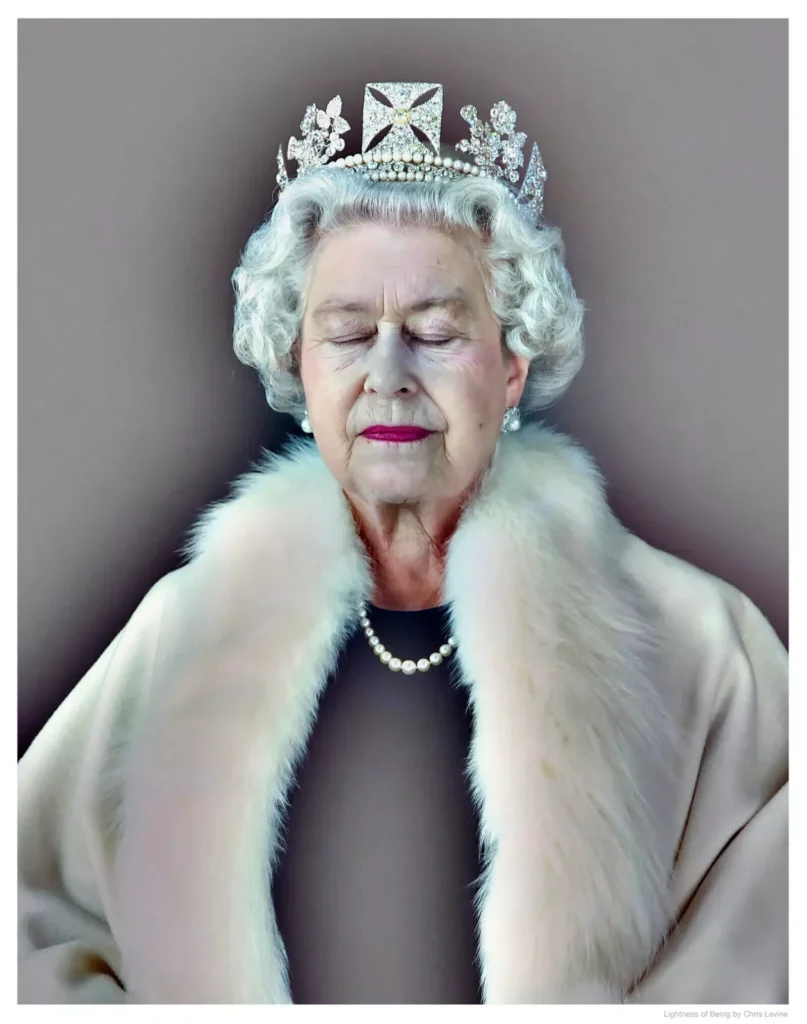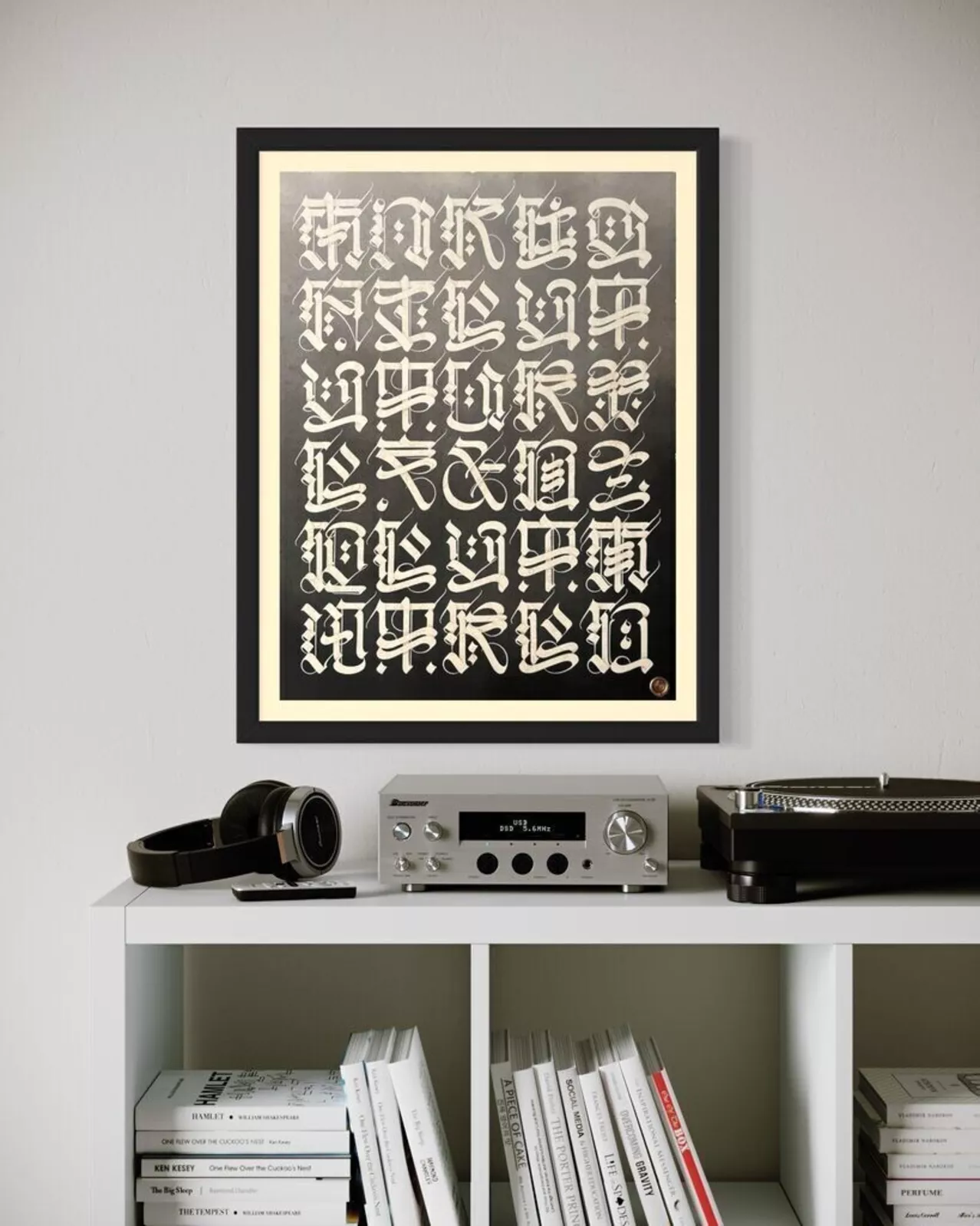In 2021, British artist Chris Levine revisited one of the most iconic and ethereal portraits of the 21st century—Lightness of Being—with the release of his Freedom Edition. This image of Queen Elizabeth II, captured in a moment of serenity with her eyes closed, has evolved beyond the realm of royal portraiture into a study of light, consciousness, and stillness. The Freedom Edition represents not simply a reissue, but a renewal—an act of liberation, both aesthetic and philosophical. It stands at the crossroads of portraiture and meditation, inviting viewers to pause, breathe, and witness the subtle geometry of being.
the art
Chris Levine’s artistic trajectory has been defined by his preoccupation with the properties of light as both subject and medium. Born in Canada and raised in the UK, Levine emerged from the world of design and technology with an intuitive understanding that light itself could be sculpted—that it was capable of expressing emotion, divinity, and energy. His works, spanning holography, laser projections, and lenticular installations, occupy a distinct place between physical and metaphysical planes.
In an era dominated by noise and acceleration, Levine’s practice represents an almost monastic pursuit of stillness. “Everything is energy,” he has said, a statement that underpins both his technical approach and spiritual sensibility. For Levine, light is not just illumination—it is consciousness materialized.
idea
The original Lightness of Being photograph was captured in 2004, during Levine’s commission to produce a holographic portrait of Queen Elizabeth II for Jersey’s 800th anniversary of allegiance to the crown. Working over several days at Buckingham Palace, Levine employed a 3D camera system that recorded thousands of stills as part of the holographic process. Between these formal captures, there was a fleeting moment—a breath—when the Queen closed her eyes.
It was an image never intended to be the final portrait, yet in that suspended instant, Levine discovered something timeless. The Queen, unguarded and reflective, seemed to transcend her symbolic role, embodying instead the universal human experience of presence and peace. The photograph was later developed as Lightness of Being, a work that transformed the language of official portraiture.
still
What makes Lightness of Being so enduring is its radical intimacy. In place of regal command or stoic posture, Levine presents an image of inwardness—a monarch rendered as pure consciousness. The eyes closed not in fatigue but in meditation; the faint glow of light forming a halo-like aura.
This visual language draws from Levine’s long-standing engagement with Eastern spirituality, sound frequencies, and meditative states. The Queen, seen through this lens, becomes less a subject and more a vessel—a conduit for light. Levine’s technical precision fuses with his transcendental curiosity, yielding an image that feels both ancient and futuristic, deeply human yet cosmically vast.
evolve
By 2021, the world had entered a new chapter of collective introspection—emerging from isolation, facing the realities of mortality, and redefining freedom in the wake of global crisis. Levine’s Freedom Edition of Lightness of Being was born within that cultural moment. It marked not a repetition of the original, but an evolution—a reinterpretation aligned with the changing spirit of the times.
The edition recontextualizes the Queen’s image through the prism of liberation. While the original piece evoked serenity, the Freedom Edition adds luminosity and chromatic subtlety, exploring the idea that freedom begins within—the freedom to be still, to connect, to exist in the space between breath and light.
Rendered using advanced pigment printing and backlit techniques, the Freedom Edition radiates a gentle pulse, an almost living presence. Levine’s layering of spectral color—rose-gold hues and soft cyan halos—transforms the static portrait into something closer to a light sculpture. Each print feels alive, changing subtly as ambient light shifts, reaffirming Levine’s lifelong devotion to impermanence and perception.
perception
Levine’s work consistently engages the relationship between vision and awareness. Projects such as Angel Presence, Equanimity, and Stillness at the Speed of Light all explore how light can reflect states of being. In Lightness of Being / Freedom Edition, this exploration reaches its most distilled form.
The Queen’s meditative pose becomes a mirror through which the viewer confronts their own consciousness. There is no spectacle here, only presence. The longer one observes, the more the boundaries between subject and observer dissolve. It is an experience that echoes Levine’s installations at festivals like Glastonbury and the Eden Project, where light and sound are used to orchestrate collective meditation.
In this sense, Freedom Edition operates not only as portraiture but as a spiritual device—a visual mantra for mindfulness in a distracted world. Levine’s technical mastery (using laser scanning, precision printing, and LED integration) becomes inseparable from his philosophical intent: to make light the language of awakening.
subtle
It is impossible to ignore the socio-political resonance of Lightness of Being in a post-monarchic world. When the Queen passed in 2022, the image resurfaced as the defining visual of her legacy—not as ruler, but as being. The Freedom Edition, released a year earlier, now appears almost prophetic.
Its title invites multiple readings: freedom from identity, from form, from the material trappings of power. It speaks to a kind of inner sovereignty—a state of grace that exists beyond politics or portraiture. In this sense, Levine’s Queen becomes an icon of transcendence rather than authority.
The paradox is profound: the most famous woman in the world, captured in a moment of complete anonymity. No regalia, no crown—only light.
style
For Levine, light is not a metaphor for truth or divinity; it is the truth itself. His process integrates optical science, quantum theory, and meditative practice into a unified vision. Using lenticular printing, laser arrays, and holographic layering, he constructs works that change depending on the viewer’s position and attention.
The Freedom Edition embodies this dynamic relationship. It refuses to be fixed. Under daylight, the portrait appears soft and ethereal; under LED illumination, it glows with spectral intensity. This mutability suggests that reality itself is a play of perception—that being is not static but vibratory.
Levine’s fascination with this phenomenon aligns with his study of the “zero-point field”—a concept from quantum physics describing the vacuum energy that pervades all existence. To him, art is a means of tuning consciousness to that field, of aligning the viewer with the frequency of light.
leg
What distinguishes Levine’s approach from other contemporary portraitists is his ability to merge technology and spirituality without irony. His practice is not about digital manipulation but about consciousness amplification.
In a world saturated with imagery, Lightness of Being / Freedom Edition invites slowness. It asks the viewer to experience time differently—to dwell in the quiet intervals between gaze and understanding. The Queen’s closed eyes remind us of inward sight, the kind of seeing that transcends looking.
This quality has made the work a touchstone across generations, appearing in major collections from the National Portrait Gallery to the Lightbox Museum. It also speaks to a broader cultural hunger for mindfulness—a yearning for stillness amid motion.
fin
Lightness of Being / Freedom Edition is more than a portrait; it is a meditation rendered visible. Chris Levine has not merely captured the likeness of a monarch—he has revealed the architecture of awareness itself. The work transcends image-making to become an exercise in perception, energy, and grace.
In 2021, as the world redefined freedom in the shadow of isolation, Levine’s portrait offered an alternative vision: that freedom is not external but internal. It is the still point within motion, the silence behind sound, the light that exists in all beings.
Through this luminous reimagining, Levine achieved what few contemporary artists can claim—to make light both the subject and the message, the medium and the meaning.
No comments yet.








